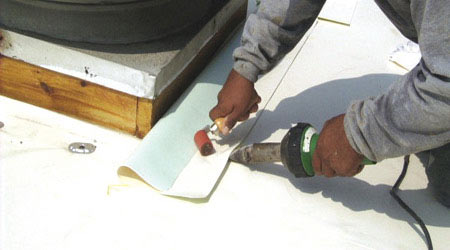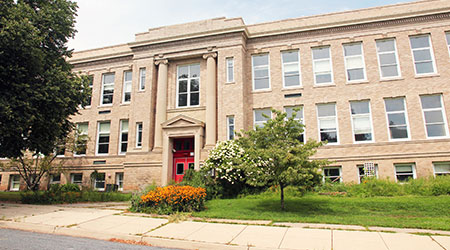
5 Tips for Flat Roof Maintenance
August 2, 2017
Maintenance is an essential part of preserving the integrity of a flat roofing system. Generally roofs should be inspected twice a year — once in the spring and then again in the fall. While an inspector will perform these formal inspections, it’s important that you as the building owner are aware of potential issues with your roof year round. In order to help keep your roof performing at its best, make sure to look for the following five scenarios throughout the year.
1. Ponding Water
Ponding water is defined as accumulated water that does not evaporate or disappear within 48 hours of conducive drying conditions. If ponding water is not taken care of, roofing systems can experience membrane degradation resulting from exposure to magnified UV rays, the presence of algae, or accelerated heat aging. If your roofing is experiencing ponding water, be sure to contact your contractor or manufacturer to resolve the problem.
2. Blistering
When examining your roofing system, be sure to looking for the blistering of the materials. Typically, your roof will look like it has sections of raised strips on top of the surface. Blisters that are neglected can pose a serious threat to the integrity of your flat roofing system. This is because liquid is trapped between sections of membrane and then, as it becomes vapor, expands. By taking care of any blisters as soon as you notice them, you can prevent water from continuing to seep into your roofing system, preventing further degradation.
3. Cracking
A variety of factors can cause cracking in your roofing system. Some roofing systems are more susceptible to damage caused by UV rays; the UV breaks down the membrane and causes cracking and crazing. In other scenarios, poor workmanship could be to blame. Surface stress caused by excessive weight on your roofing system is another common cause of cracking. Regardless, this cracking could lead to more serious problems down the line and should be addressed immediately when found.
4. Snow Build Up
Although this scenario is more common in colder climates, snow should not be ignored on your roofing system. Since your roof is flat, the snow won’t be able to slide off your system as easily as it would on a sloped roof building. Excess snow can overload the roofing system and cause the roof to collapse. On the other hand, if the snow melts and the roof is not draining properly, you’ll run into a ponding water scenario. Be sure to hire someone to remove the snow if you are worried about your roof, especially if the snow exceeds a foot. Every year serious injuries occur due to inexperienced owners who are trying to do DIY snow removal.
5. Loose Fasteners
Loose fasteners can spell disaster for flat roofing systems. When fasteners become loose they no longer anchor the roofing system to your building as intended, causing your roof to be more susceptible to wind damage and potential tear-off. Installation instructions specify the type of fasteners that need to be used on your roofing system. If your contractor uses the wrong ones, your warranty could be voided.
Overall, maintenance routines need to be set in place immediately following the finished construction of your roofing system. Don’t forget to ask your inspector vital questions during your bi-yearly inspections to ensure you are protecting your roofing system, and building, from danger.
This Quick Read was submitted by Ralph Raulie, senior technical and product manager for FiberTite Roofing Systems. He serves on the Research Committee at the Center for Environmental Innovation in Roofing. Click here to read more about roof asset management on Facilitiesnet.com.
Next
Read next on FacilitiesNet












